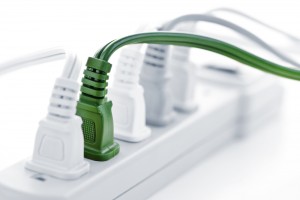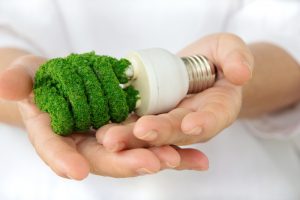Introduction
Energy efficiency is the cornerstone of My Green Doctor. This is where a doctor’s office can capture the greatest financial savings and make the strongest community impact. Most of our offices are planned for patient care, and rarely with consideration for the cost of office operation and energy usage. Yet utility costs add substantially to the cost of doing business.
The word “energy” was coined by Aristotle, the 4C BCE Greek philosopher, to mean “at work.”When we use electric power we are getting work accomplished.”Energy efficiency” is the wise use of this work.
There are two key tenants to remember as you approach this topic: first, the cheapest kilowatt for your office will be the one that you never use, so cut your power use wherever you can; and second, look immediately for the “low hanging fruit,” the quick and inexpensive ways to save.
We provide dozens of Action Steps that your office can adopt for lowering your energy use and saving money. This will reduce the fossil fuels used to generate electricity, reducing both your nation’s fuel bill and air pollution & greenhouse gases from the burning of these fuels. Every idea in this Workbook can be taken home to share with your family and your patients’ families.
Energy Efficiency Action Steps
We offer 50 Energy Efficiency Action Steps and Education Steps for you to consider for your office. We suggest that you begin with the five “Quick Start, Now!” Action Steps.
At your next meeting, consider some of the “Advanced Route” Action Steps for Energy Efficiency. Some of these require more planning and teamwork but they offer great long term rewards. A thorough energy efficiency plan may take months to formulate.
Finally, consider the “Education” Action Steps for Energy Efficiency in order to share energy concepts with your staff, families, and patients.
We will lead you through each action step and challenge your Green Team to create new ideas by asking, “What else?” Please email us your ideas to add to the Workbook. These suggestions will help you toward Green Doctor Office Recognition.
Quick Start Now! Action Steps for Energy Efficiency
Adopt a policy to turn off lights, computers, monitors, fax machines, copiers and printers at night. This saves a lot of energy and money. Set computer monitors to “sleep mode” if they must stay on. Plug all machines into power strips to make it easy to turn them off at night with just one button. You might tape reminder messages onto machines to “Please turn me off!”. Speak with your janitorial staff who might be leaving the lights on at night.
Issues to discuss:
- Can we agree to do this?
- Do a quick mental inventory of your machines & lights: are there some that must stay on?
- Who will be the leader for this Action Step and report back at the next meeting?
Does your office receive monthly energy bills? If you are in a large building, you may not receipt a separate bill for the energy that you use. If you do get monthly bills, ask one Green Team member to gather your bills for the past year, and to report your future energy savings every 2-3 months. Your utility’s website likely can tell you how to calculate how much carbon dioxide you are reducing – the greenhouse gas that is causing most climate change.
Issues to discuss:
- Can we agree to do this?
- Who will be the leader for this Action Step & report back in 2-3 months?
Change all incandescent lights (those with filaments inside) to Compact Fluorescent Bulbs (CFB’s) or to Low Emitting Diode (LED) bulbs. LED’s are preferred because they use so very little electricity. A 75-watt incandescent bulb is replaced with a 25W CFB.
Issues to discuss:
- Can we agree to do this?
- Do we have dimmer switches that don’t allow bulb changes?
- Do we have a plan to discard used bulbs properly? Fluorescent bulbs contain mercury, a potent neurotoxin. The typical CFB contains 5mg, compared with 100mg in a mercury thermometer. Most large hardware stores accept used fluorescent bulbs and will dispose of the mercury safely. You also can call your trash collector or local government. For general recycling advice, try http://www.recycling-guide.org.uk/rrr.htm.
- Who will be the leader for this Action Step and report back at the next meeting?
Adopt an office policy to set thermostats to 74 degrees F (23 C) in the summer and 68 F (20 C) in the winter. Put reminder stickers on the thermostats for these settings.
Issues to discuss:
- Can we agree to do this?
- Do we need to coordinate this with the building manager?
- Who will be the leader for this Action Step and report back at the next meeting?
Most doctor offices can turn off their hot water heaters, without health consequences. Hand-washing requires soap & water, but not heat. A large public health clinic in Pensacola, Florida studied this option, found it to be safe, and is saving hundreds of dollars annually.
Issues to discuss:
- Can we agree to do this?
- Who will be the leader for this Action Step?

Keep Going! More Action Steps for Energy Efficiency
Learn how much energy you use and how you use it. You can perform your own office energy audit or make use of free audits that are provided by most local electric utility companies, either in person. This service is provided because utility providers are encouraged by the government and by the marketplace to promote wise energy use in order to avoid building expensive power plants and to avoid burning fossil fuels. Click here to learn more about calculating your annual contribution to greenhouse gases. A straight-forward calculator is available from the US Environmental Protection Agency (EPA): https://www.epa.gov/ghgemissions/household-carbon-footprint-calculator .
A carbon footprint is a measure of the amount of greenhouse gases, including carbon dioxide, emitted as the result of the activities or operations of a person, household, business, medical practice, or other entity. Carbon dioxide and other pollution are created when electricity is produced by your utility company by burning non-renewable fossil fuels such as coal, natural gas, and petroleum. Using your electric bill and other simple information, you can easily calculate your family’s or your medical office’s annual greenhouse gas production — your “climate footprint.” A straight-forward calculator is available from the US Environmental Protection Agency (EPA): https://www.epa.gov/ghgemissions/household-carbon-footprint-calculator. This calculator considers daily activities including your use of electricity, transportation methods, and disposal of wastes. These are the most common sources of household or office greenhouse gases. Of course, the EPA calculator will not be accurate for households that use wood, charcoal, animal dung, peat, or coal for home heating or cooking. You may find an online calculator that is better for your community.
Conserving energy can be as simple as turning off the lights when they’re not in use. Put “Please turn me off” stickers on switches, including in the waiting rooms. These can easily be made with the label printing program that is likely on your desktop computer at work. Teach members of the office and the cleaning team. Turn off lights when closing the office at night, but also when the natural light from windows is adequate during the daytime. Why not start a friendly office competition to see who can turn off the most lights each week?
Adopt a policy to not replace burned-out tubular fluorescent bulbs if the remaining bulbs in your fixture provide adequate light. Speak with your maintenance personnel so that they understand your decision. Decide how you will explaing to everyone working in the office about lighting options and the policies you have adopted. In addition to these steps, also consider:
The simplest way to build a greener office through the use of office equipment is to adopt a policy to turn off lights, computers, monitors, fax machines, copiers & printers at night. This saves a lot of energy and money. Set computer monitors to “sleep mode” if they must stay on. Put reminder messages on machines to “Please turn me off!” Speak with your janitorial staff who may leave lights on at night.
To make it easier to turn machines off, you can buy power strips into which you can plug multiple machines, making it easier to turn off several machines when closing the office at night. Ask office members if they can use power strips for their office spaces.
Your office can adopt an office policy to ask employees to engage the energy-saving buttons after they have completed using a copier or fax machine. Try to do this every night when the office closes. Place a small sign on devices to tell users which button to use. Mention this at staff meetings. This saves energy, reduces the heat generated by machines, and cuts down on the noise.
Control the temperature of your office thermostat. Adopt an office policy to set thermostats to 74 degrees F (23 C) in the summer and 68 F (20 C) in the winter. Put reminder stickers on the thermostats for these settings. Assign a Team Member to inspect the office thermostats weekly or as needed. Communicate thermostat settings with those working in the office. Encourage the wearing of comfortable, climate-appropriate clothing, such as open-collars and short-sleeved shirts during warm weather; sweaters and coats during cool months. Use natural, cool materials.
To ensure maximum protection, upgrade your windows. If your building is over ten years old, it may pay to upgrade to double-paned, insulated glass. Low interest loans or grants may be available from your government, utility company, or your bank. Contact your utility company, energy consultant, building manager, or architect.
Consider turning off your hot water: Turn off the hot water machines for your entire building. This Action Step was researched and adopted in 2010 by the public health specialists of the Escambia County Health Department and found to be safe and to produce large savings of money and carbon emissions. Their five outpatient clinics care for complex patients including ones with serious infectious diseases, but they found that you do not need hot water for effective hand-washing. If you do wish to keep your hot water heater, set the temperature to 120 degrees F (48 degrees C), no higher.
What else? Please email us your “What Else” ideas for us to add to the Workbook. These suggestions will help you toward Green Doctor Office Recognition.
Tips for Success
Your Improvement Plan consists of the Action Steps that you choose to adopt for the office.
For each action step:
- Record the conditions in your office before you start making improvements, such as your monthly electricity use. Record these data on a Green Team Notes form on a Green Team worksheet.
- Establish specific, measurable, date-certain targets for what you want to accomplish such as, “We will turn off 100% of appliances at night by September 1,” or “We will agree on and implement a thermostat setting policy for the office by January 1.”
- Agree on a leader for each Action Step.
- Agree on the responsibilities of each person in the office.
- Pick a date for a progress report for each Action Step, or a date for completion.
- Use the Green Team Notes form to keep track of your progress. Try to share this online to avoid printing paper.
- If needed, obtain agreement or approval from the office manager or chief executive.
- Communicate with your office colleagues. Listen for ideas and try to elicit helpful criticisms.
- Educate your patients, families, and community. Which ideas could be shared with your own families or with your patients?
- Part of the Green Team’s Improvement Plan must include an education plan.Your waiting room can become a site for education.
Energy Success Story
Background Information
- Free or low-cost energy audits are available for small businesses, provided by electricity companies, government agencies, and consultants. You can go online to ask if your electricity provider offers this service.
- The majority of the electricity consumed by Americans is used in homes and offices.
- In the US, 70% or more of a community’s electricity is made by burning fossil fuels, resulting in the release of air pollution, including climate-warming carbon dioxide and nitrous oxide.
- If every American home replaced one incandescent light bulb (those with a wire filament inside) with a compact fluorescent bulb (spiral-shaped bulbs), the country would save enough electricity to power 3 million homes for a year.
- A compact fluorescent bulb (CFB) saves $30-45 over the life of the bulb compared to an incandescent bulb.
- CFB’s, like all fluorescent bulbs, contain mercury and must be disposed of properly.
- Modern tubular T-8 fluorescent fixtures use less energy and provide more natural-appearing light than older fixtures.
- LED (light-emitting diode) bulbs last even longer and use very little electricity. This new type of bulb is expensive but worth it over the long run. LED bulbs are available widely.
- Installing a solar hot water heater usually pays for itself in five years. They are suitable for smaller offices that do not require a lot of washing of equipment. In most communities, subsidies are provided by the local utility company, government, or both, making these options quite affordable if the home or office has suitable sun exposure. You can call a local installer for a free building assessment and price.



